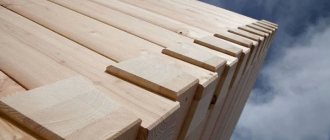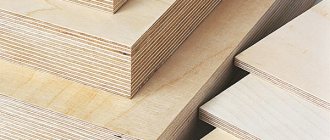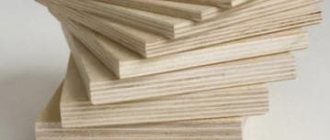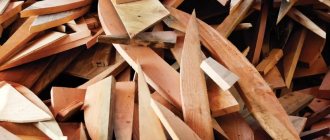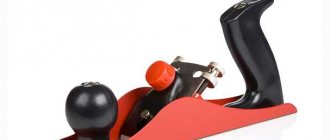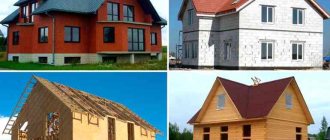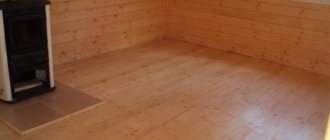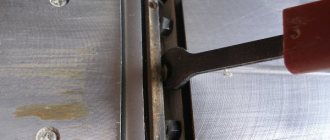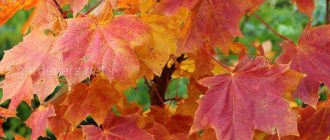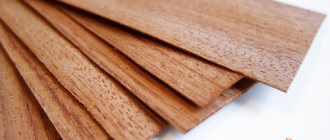Plywood is a popular wood-based building material. Hardly a single construction site can operate without its use. This material is widely used both in private low-rise housing construction and on large-scale construction projects. It is used as a subfloor and as a material for leveling the surface of floors, as cladding for ceiling and wall surfaces. It is used to construct formwork components for working with concrete and various floors. In addition, high-quality plywood is often used to decorate all internal surfaces of the room. This allows you to create the illusion that the home is built of wood, which is facilitated by the characteristic wood pattern present on the surface of this material and the warm tone. But the scope of use of plywood does not end there. It is actively used as a raw material for the production of cabinet and upholstered furniture, as well as in the production of various musical instruments.
Peeled veneer, which is made from natural wood of various species, is used as a raw material for the industrial production of this wonderful material. Veneer is a very thin section of wood, planed from so-called churaks - logs of a certain standard. The cuts are made using special equipment, removing a thin layer across the entire width of the block, which is first steamed well. This is necessary so that when cutting the veneer it becomes elastic and does not get damaged.
As a rule, a plywood board is made from 3-5 sheets of rotary-cut veneer. Each sheet is superimposed on the previous one so that the directions of their fibers are perpendicular. This arrangement of veneer gives the glued material increased strength, multidirectional, and resistance to deformation. In general, stability of shape is the property by which plywood is superior to solid wood, which is prone to deformation and is overly sensitive to changes in air humidity.
Various adhesives are used to join sheets of peeled veneer. The choice of this composition determines whether the finished plywood will be ordinary or moisture resistant. Plywood is produced in different designs, it has different grades and brands; different types of plywood supplied to the market have significant differences in performance properties.
What is the reason for such great popularity and demand for plywood? Probably, first of all, in its versatility - this material successfully combines very high strength and resistance to warping and deformation, as well as cracking along the grain, which is largely characteristic of ordinary boards. Dimensions are also important - a plywood sheet is much wider than any board, its parameters vary, which allows you to choose the best option and thereby minimize material consumption during use. Plywood is also popular due to its natural origin. An important advantage of this material is its low cost.
What is plywood made of?
Plywood is designed as a wooden raw material with layers, which has at least 3 layers. The layers contain veneer or wood bark.
When creating, the veneer is placed in a separate layer across the last one, therefore the density and strength increases, and the mixture used for gluing the layers increases the resistance to moisture.
Distinctions according to variety
- Grade E – selected species. Flaws are not permissible, except for small changes that accidentally appear in the structure of the tree.
- Grade 1 – the greatest extent of warping or cracks should not be more than 20 mm.
- Grade 2 – crevices up to 200 mm, wooden inserts, glue leakage into the plot up to 2% of the entire sheet square are allowed.
- Grade 3 - up to 10 defects per m2 are allowed, with the diameter of an individual no more than 6 mm. The total number of mentioned defects cannot be more than 9.
- Grade 4 – very low quality. May contain the following defects: sometimes fused and popping knots - without counting. Flaws in the edges of the sheet up to 5 mm.
Based on this, the grade of plywood differs in the presence and number of flaws on the plane of the wooden material.
How plywood is made
Production consists of several stages:
- First, the logs selected for production are soaked in warm water to provide the wood with the softness necessary for processing.
- From prepared churaks of a certain size, veneer is obtained, which is then leveled and dried.
- The veneer is sorted, defects are eliminated and sheets of a certain size are formed from it.
- The veneer sheets are assembled in a certain order and fastened together with glue.
- After drying the resulting bags, their edges are cut to the required format, and the front surfaces, if necessary, are sanded and covered with a decorative layer.
Obtaining veneer for plywood
Various methods are used to obtain veneer. Most often, circular peeling is used: the prepared block rotates around the longitudinal axis, and a special knife removes a thin layer from it.
The removed layer of wood is unrolled into a strip, cut into sheets and sent for further processing.
In some cases, peeling with eccentric rotation of the workpiece is used. This gives a more interesting periodic pattern due to the knife crossing the annual layers.
Flat planing is less commonly used, which makes it possible to obtain veneer with a given character of the pattern depending on the direction of processing. There are tangential and radial veneers. They differ in the location of the processing plane in relation to the radius of the log and the type of pattern that the wood structure forms. To produce veneer using this method, high-quality wood that is free from defects is selected.
For special cases, veneer is produced by sawing. This method does not require special preparation of wood and allows you to obtain a natural pattern with a natural color.
Removing defects and forming sheets
The resulting veneer contains various defects inherited from the wood. In addition, there may be damage caused by the manufacturing process itself. In addition, the primary material does not always correspond to the required sheet format. To bring the veneer to the required parameters, additional processing is carried out.
First of all, the material is selected and rejected. Unusable sheets or parts thereof, weakly bound or affected by rot, are removed and those suitable for further stages are selected. Rotten, loose and poor-quality areas are cut out. Then the individual parts are cut along the edges and glued into sheets of the required size. If necessary, knots are removed and patches are inserted in their place. Broken cracks are repaired in the same way.
Gluing
Adhesive packages are formed from prepared and dried veneer sheets. They usually contain an odd number of layers. The central layer is laid as a structure in the transverse direction, each subsequent layer at right angles to the previous one. The direction of the outer layers on both sides coincides and is considered longitudinal.
There is plywood with an even number of layers. In this case, the two central layers have the same structure direction. All layers, as a rule, have the same thickness. But GOST specifically states the requirement that the layers located symmetrically relative to the central one be identical.
Veneer gluing is done using a press and high temperature. The press ensures uniformity and minimal thickness of the adhesive layers, and heat is necessary to cure the resin. After gluing, the sheets are kept in bags to cool evenly and equalize internal stress and humidity.
Trimming
The glued boards are cut at the edges on special machines. This operation produces straight edges and ensures accurate sheet format.
Types of glue for plywood
- FSF - consists of phenol-formaldehyde, has the highest degree of moisture resistance. Since it contains harmful compounds in its contents, it is not recommended for the manufacture of furniture or in residential buildings.
- FKM - contains melamine, has a satisfactory level of resistance to moisture. It has a reduced amount of harmful components, as well as lower moisture resistance, therefore it can be used wherever high requirements for moisture resistance and toxicity parameters are not imposed.
- FC – contains urea, has a low degree of moisture resistance. It does not contain harmful components, therefore it can only be used for the interior design of living rooms, kindergartens, and furniture.
- FBA – consists of albumin and casein. The product is not resistant to moisture. This plywood is environmentally friendly and can be used anywhere where increased resistance to moisture is not required.
Plywood grades depending on water resistance
FK grade plywood - gluing is done with urea resin. Designed for indoor use.
Plywood brand FSF (increased moisture resistance) - layers are glued together with phenolic resin. Can be used both indoors and outdoors.
FB grade plywood (bakelized plywood) - glued together after impregnation with bakelite varnish. Can be used in tropical climates, sea water and other types of aggressive environments.
FOF plywood (laminated plywood) is birch plywood lined on one or both sides with a film coating (paper impregnated with synthetic resin).
Types of plywood by plane
Differences between plywood based on the created top ball:
- Laminated - to strengthen all the properties of wood, the outer layers are covered with a special film for additional protection of the plane;
- Sanded on both sides (W 2);
- Sanded one side (W 1);
- Not polished (NS).
The plane of the plywood can be sanded in order to neutralize flaws and provide it with a more beautiful appearance.
Often laminated and sanded are used for final or aesthetic finishing, as well as for the formation of visible furniture elements.
Where is plywood used?
Due to its unique properties and low price (compared to natural wood), plywood has found its application in many areas. This timber is most often used in the following areas:
- Manufacturing of roof decking.
- External finishing of buildings and structures.
- Production of decorative elements, souvenirs.
- Decorative wall decoration.
- Ceiling leveling.
- Van upholstery, automotive industry.
- Laying the final floor covering.
- Alignment of walls.
- Furniture manufacturing.
- Monolithic construction.
- Laying subfloors under laminate, linoleum, parquet, etc.
Note that there are a huge number of types of plywood on sale, each of which is characterized by its own distinctive properties. To determine for yourself in which areas it is most appropriate to use one or another type of plywood boards, you need to know their main differences.
Types of plywood by wood type
According to the type of wood veneer, there are 3 types: coniferous, birch and composite type. To do this, only the contents of the outer layers are examined.
Let's take a closer look:
- Coniferous species. The layers of this plywood are made from the bark of coniferous trees. In the Russian Federation, they are mostly made from spruce and pine. It is not as strong as birch, but its weight is 20% less, and its contents contain natural resins that protect it from damage and decay. It also has a beautiful plane ornament and its cost is less than that of hardwood. Due to the fact that its main advantages are in weight, cost and aesthetic surface - raw materials are often purchased for private construction, the following are created: partitions, roofs, decking, various outdoor and indoor decoration, also for decorative products, as well as in design;
- Made from birch - classified as a deciduous type of plywood required for construction. Birch bark veneer is a very strong and compacted material with a uniform structure. The density of the described plywood is 650 kg/m3 - this indicates that a sheet made from such raw materials has 20% greater strength than those made from other types of wood. It does not contain natural resins and is more expensive than others;
- Composite - layers of compatible plywood accommodate different types of hardwood and coniferous wood. In terms of quality parameters, it is close to the birch product, but its cost is cheaper. It is used in construction work, furniture making, packaging and other areas.
Technical characteristics of plywood
Strength and density of plywood
The strength of plywood depends on the characteristics of the original wood and the bonding strength. Strength is indirectly indicated by the density of the material. As a rule, the density of plywood ranges from 550-750 kg/m3, that is, it approximately corresponds to the density of wood or slightly exceeds it due to the higher density of the resin that holds the veneer together.
GOST provides for different density levels for ordinary plywood - from 300 to 1000 kg. Low specific gravity is possible when using light wood and “loose” veneer. Weighting occurs due to the use of denser resins and other manufacturing features of a particular type of material. For example, bakelized plywood can have a density of up to 1200 kg/m3. It is also characterized by the greatest strength.
The main, most important indicators of plywood strength are the bending strength and the holding strength of fasteners. The bending strength of FSF and FK plywood is approximately 3-4 times lower than that of solid wood. The FBS and FBV grades are superior in strength to the original wood. The resistance of screws to pulling out is quite high due to the pronounced layered structure (when installed in a face) and reaches 6-8 kg for every millimeter of fastener length.
Environmental friendliness
The environmental properties of plywood are characterized by its emission class. The best brand in this regard is FBA. There are no synthetic materials in it at all.
All other brands of plywood are, to one degree or another, sources of volatile formaldehyde. For use in residential premises, you should choose materials with emission class E1 and lower. Interestingly, GOST provides only class E1 for laminated plywood.
Biological resistance
Plywood is not immune to rot, blue staining (for conifers), and mold. However, plywood's resistance to biological damage is higher than that of ordinary wood. This is due to the fact that the veneer is in direct contact with phenolic or urea resins, which partially perform the functions of an antiseptic. Coniferous veneer has higher resistance due to the characteristics of the wood. Bakelized plywood has the greatest resistance.
In any case, you should take into account the operating conditions of the material and choose the one suitable for them or carry out additional antiseptic treatment.
Flammability
Plywood is a highly flammable material. This must be taken into account when using it. The fire resistance of structures and products made from it can be increased by special treatment. There is also a special, difficult to combustible grade of plywood - FSF-TV.
Moisture resistance
The moisture resistance of the most popular FSF and FK varieties is demonstrated by the sheet delamination test, which is carried out after heavy moisture. Before testing, FC plywood is soaked in water for 24 hours, FSF grade is boiled for an hour, and, by agreement with the customer, for 6 hours. Brands FBS and FBV are also subjected to hour-long boiling.
After treatment with water and drying, the tensile strength of the adhesive layer for different brands is:
- FC and FSF - from 2 to 10 kgf/cm2 (0.2-1 MPa);
- FBV – 14.7 kg/cm2;
- FBS – 17.6 kg/cm2.
The FBS brand is suitable for tropical climates and other difficult conditions.
Insulating properties
Plywood can be used as part of external enclosing structures. In this application, its insulating qualities are taken into account.
Moisture permeability.
Any plywood can absorb water and is therefore permeable to moisture. However, the moisture permeability of the material is capillary in nature and depends on the type of impregnation. In any case, when one side is moistened, moisture will penetrate to the opposite side and can be transferred to adjacent layers of the enclosing structure.
Thermal conductivity.
The thermal conductivity of plywood depends on its density and can range from 0.09 to 0.25 W/(m∙K). For the most used brands, the thermal conductivity of the material is close to wood.
Vapor permeability.
Permeability to water vapor is an important parameter that is taken into account when calculating multilayer structures enclosing rooms with an artificial microclimate.
The vapor permeability of plywood is approximately three times lower than the permeability of wood in the direction across the grain, and five times lower than the permeability of brickwork. This property in some cases can be used for vapor barrier of walls from the inside, and must be taken into account when using plywood for external cladding.
Types of plywood by purpose
Plywood rectangles are useful not only for building houses and decorating rooms.
It is used much more widely:
- Furniture type. It is wear-resistant and is also considered environmentally safe. Basically it is a composite product of FA, suitable for being in conditions of average moisture levels;
- Construction view. Sheets made from birch are perfect for any type of rough sheathing;
- Formwork type. Plywood marked FB, due to its high strength and moisture resistance parameters, will be able to remain in an environment of negative, natural influences;
- Decorative variety. This plywood is designed for finishing interior cladding, often using high-quality veneer. Here you can see the very aligned, outer planes of the sheets; relief marks are visible on them;
- Ship's view. For the construction of ships, moisture-resistant FB sheets are often used; bakelite glue is used to produce them;
- Automotive type. FSF plywood is used to trim truck bodies. Plates are taken with lamination, and sometimes with a mesh-ribbed outer plane.
Applications of construction plywood
Construction plywood is used for finishing vehicles or ships, in the construction of warehouses or retail premises, in the construction of containers, loading docks, in the construction of dams, bridges and other large structures, but most often for formwork. For this, 18 mm thick sheets of 2440x1220 mm or 3000x1500 mm format are usually used.
Construction plywood 10 mm , 12 mm, 15 mm and up to 40 mm is used in any other construction industries. But in general terms, birch veneer is used where it is necessary to cope with high mechanical loads, and coniferous veneer, which has less weight and density, is used as a base for a soft roof.
Of course, this building material is not limited to the listed areas of use. Its scope of use is very wide, but it is impossible to mention everything.
Plywood sheet sizes
The standardized width of plywood sheets is 1220 and 1525 mm.
- The maximum mini length is 1525 mm, and the longest reaches 2500 mm.
- Nowadays, manufacturers often offer rectangular-shaped slabs with dimensions of 2440×1220 mm, and also square-shaped slabs with dimensions of 1525×1525 mm.
- With the exception of large format products, the length for them can be 3050 mm. The thickening of plywood is determined by the number of layers.
According to GOST standards, there are prescribed parameters - from 3 - 30 mm.
There are also standards in force that enable individual, special companies to produce slabs with a thickness of over 1 mm.
Which plywood is better to choose?
The composition and future functions of the material should be determined by your everyday needs, i.e. You need to choose plywood depending on how and where you want to use it. Plywood laid on the floor must certainly be waterproof, otherwise after some time it will get wet and turn into a mushy mass.
Also, material of the appropriate quality cannot be made from the same type of wood.
Plywood, according to its functions, can be of the following types:
- construction (main)
- waterproof
- for the production of frame furniture
- laminated
- decorative
Having determined the scope of future work, you can begin to select a variety. Varieties of plywood differ in the quality of the glue. The adhesive material is quite an important aspect.
Photos of all types of plywood
Varieties and labeling
There are five grades of plywood. The highest is E (Elite), and then, as it gets worse, from I to IV. The grade is determined by the condition of the upper - front layers. Moreover, the quality of both surfaces is assessed separately and written through a slash. For example, I/II or III/IV.
GOST describes in detail what surface errors are permissible for which grade; there are special tables by which this grade is determined. If at least one parameter is worse than acceptable, the grade is reduced.
Varieties differ in the presence and size of certain defects
Here are the features on the front surface that different types of plywood may have.
- Elite For this brand of plywood, the veneer must be perfect. There may only be minor changes to the wood (no eyes). All. There should be no other shortcomings.
Grade E (Elite) must not have any defects - I grade . There may be knots: pin knots, no more than 3 pieces per square meter;
- healthy, fused, dark and light with a diameter of 15 mm, no more than 10 pieces/m², they may have cracks no more than 0.5 mm wide;
- partially fused, not fused, falling out with a diameter of no more than 6 mm in an amount of no more than 3 pcs/m²;
Only minor features are acceptable in small quantities
- Knots: pin knots without restrictions;
There are already more serious defects here
- Knots: pin knots without restrictions;
The difference in knots and their type
- length no more than 300 mm no more than 2 pieces,
- Knots: pin knots;
- length no more than 300 mm without restrictions;
Conformity of plywood grade designations according to various standards: GOST 3916.1-96, TU 5512-002-00255214-2000, GOST 10.55-71
If there are defects not listed in GOST, the product is considered non-grade. It is also considered substandard if the maximum permissible size of defects is exceeded. Sometimes they try to sell such products as a fourth grade, but this is a re-grade and the price for it should be significantly lower.
By the way, if there are no obvious cracks or fallen knots, the third grade can be used for interior finishing. In certain interiors it looks even more interesting than E or the first, which are simply a flat sheet without any features inherent in wood.
Criterias of choice
The choice depends primarily on the purpose and operating conditions
. When choosing plywood, several parameters are taken into account:
- They purchase products from well-known brands and take into account the location of the factory.
- The purposes of use determine the appearance, so for visible furniture facades they buy products of the highest quality, and for wall coverings it is more economical to choose products with one processed side.
- Operating conditions - only moisture-resistant and laminated plywood is suitable for outdoor use.
- Size , based on preliminary calculations, a product is selected in such a format that in the end there will be a minimum of waste.
An important factor is the price , which is higher than that of other sheet materials. For example, it is better to choose chipboard for furniture, and cement particle boards for cladding external walls.
Influence of parameters on the area of application
The more layers in a sheet, the stronger it is, and the larger the plywood format, the fewer joints are created when cladding walls and partitions or laying floors. This is what guides the selection of material by size.
But in the case of overall dimensions, other nuances must be taken into account, in particular, the shape and area of the surface to be finished. For example, if a wall has parameters of 2.5 x 5 m, for its cladding it is better to choose not standard, but large-format sheets, otherwise you will end up with a lot of waste.
When installing a subfloor on a concrete screed, it is recommended to lay plywood in small squares, since when attaching a large sheet, stresses arise in it. Sheets of 1220x1220 mm are suitable for this work; others will have to be cut into pieces.
Even scraps can be used in the layout on the floor Source oboiman.ru
Surface treatment type
Plywood is also classified according to the type of processing of the outer layer of the plywood sheet. Happens:
- Laminated plywood. It is created by covering the sheet with waterproof compounds, most often varnishes.
- Sanded plywood on one side.
- Sanded plywood on both sides.
- Not polished.


